Find out about monarch caterpillar stages with pictures and facts.
The monarch butterfly, like all butterflies, goes through 4 main developmental stages: egg; larva (caterpillar); pupa (chrysalis); and imago (adult butterfly).
What many people don't know is that, as a caterpillar, the monarch also goes through several stages of development. On this page we’ll find out about the 5 monarch 'instars'; the stages a monarch caterpillar goes through before pupation…
Monarch Caterpillar Stages
Most people know that the life cycle of the monarch butterfly has four distinct stages: egg, caterpillar, chrysalis and imago (the adult butterfly).
- You can find out about each of these stages on this page: The Life Cycle of the Monarch Butterfly
What many people don’t know is that the monarch caterpillar itself has five stages of development. At the end of each stage the caterpillar molts (moults in British English).
By shedding its skin the caterpillar is able to continue growing; each successive stage is larger and heavier than the last. The caterpillar also undergoes slight changes in appearance at each stage.
By the end of the fifth stage of the monarch caterpillar’s development, it will have reached the size and weight required for pupation (i.e. turning into a chrysalis).
Before its fifth and final molt, the caterpillar attaches itself to the underside of a leaf or other suitable surface. The final molt, which is performed while the caterpillar is hanging upside-down, reveals the cocoon in which the caterpillar will metamorphose into a butterfly.
Instar
‘Instar’ is the term used for a stage in an insect (or other arthropod’s) development. The newly-hatched monarch caterpillar is the first instar. After the first molt it is known as the second instar, and so on.
Monarch Caterpillar Stages With Pictures
The time the monarch caterpillar spends in each instar is dependent on temperature.
Because there can be considerable differences in size between individuals in the same instar, other characteristics should be taken into account when attempting to identify the stage in which a caterpillar is in. Take a look at the following pictures so you know what to look out for…
First Instar
During this stage the caterpillar is between 2 and 6 mm in length and lacks tentacles. Fine hairs (known as setae) can be seen on the caterpillar’s body.
On hatching, the caterpillar eats its egg then starts eating the leaf of the milkweed plant on which it was laid.
If disturbed, both first and second instar caterpillars will drop from the leaf and hang by a fine thread. The thread is produced by silk-producing organs called spinnerets which are located in the caterpillar’s head below the mouthparts.
The caterpillar remains in the first instar stage for one to three days.
Second Instar
Also visible at this stage are the caterpillar’s front tentacles. The back tentacles have begun to develop, but at this stage are very small.
The second instar monarch larva has a greater number of bristle-like setae.
Second instar monarch larvae are between 6 and 9 mm in length.
The monarch caterpillar spends a similar amount of time in the second instar stage as it did in the first (1 to 3 days).
Third Instar
The front pair of legs are smaller than the other two pairs and have started to migrate slightly nearer to the caterpillar’s head.
Rather than hanging from a silk thread if disturbed, by the third instar monarch caterpillars will drop off the leaf entirely and curl into a ball. Also by this stage the monarch caterpillars have begun to eat along the edges of leaves.
As with previous instars, the monarch spends from one to three days in the third instar, depending on temperature.
Fourth Instar
By the fourth instar the monarch caterpillar is between 13 and 25 mm in length. The front tentacles are now 5mm in length, while those at the back are around 2 mm in length. White spots on the caterpillar’s prolegs (the 5 pairs of 'false' legs at the rear of the larva's body) are more easily visible.
This stage lasts from 1 to 3 days.
Fifth Instar
In its fifth instar, the monarch caterpillar is between 25 and 55 mm in length. Its front tentacles are around 11 mm long, and those at the back are 4 mm long. The white dots on the prolegs are by now very distinct, and the front legs noticeably smaller than the others and closer to the head.
The monarch caterpillar spends between 3 and 5 days in this stage of its development.
At this stage the caterpillar is at its largest, and has an almost plump appearance. It may be found away from milkweed plants as it seeks a suitable place in which to pupate.
When a suitable spot is found, the caterpillar creates a silk pad on the underside of a leaf. It then hangs head down from the pad and undergoes its fifth and final molt, with the outer surface of the chrysalis appearing from under the skin as it is shed.
After spending 10 to 14 days as a chrysallis, the adult monarch butterfly finally emerges.
Discover More with Active Wild
- You can find out more about the monarch butterfly (including its incredible migration) here: Monarch Butterfly Facts
- Find detailed information about the monarch’s life cycle: Monarch Butterfly Life Cycle

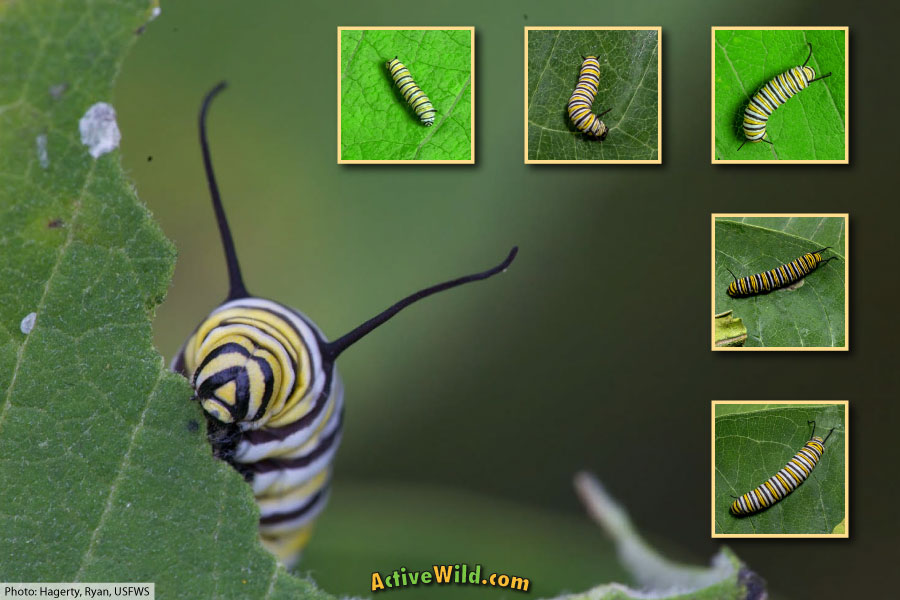
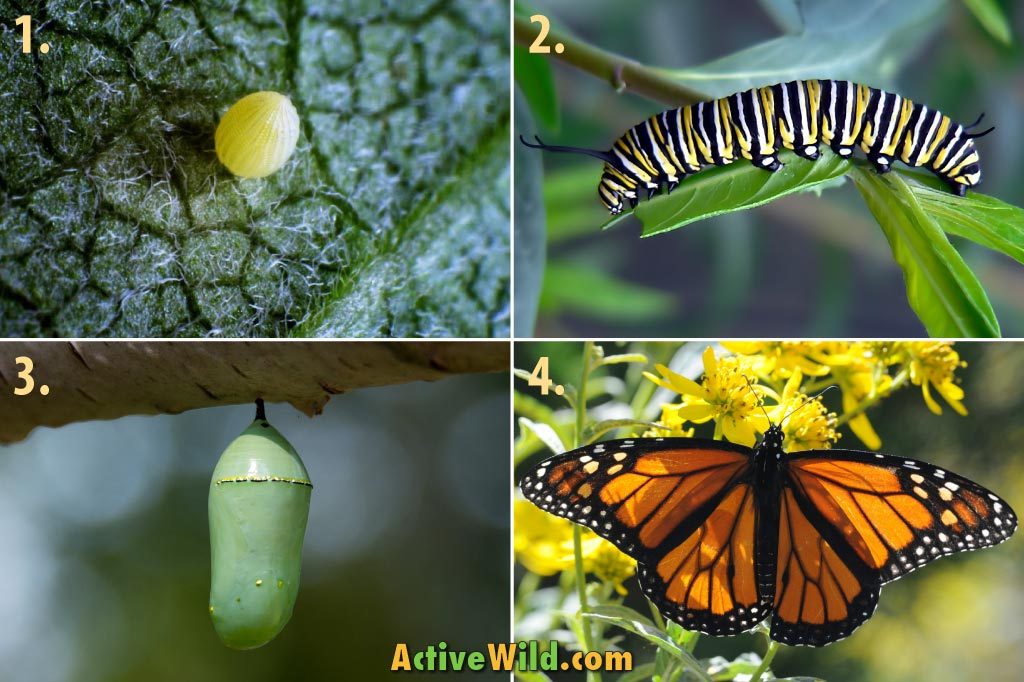
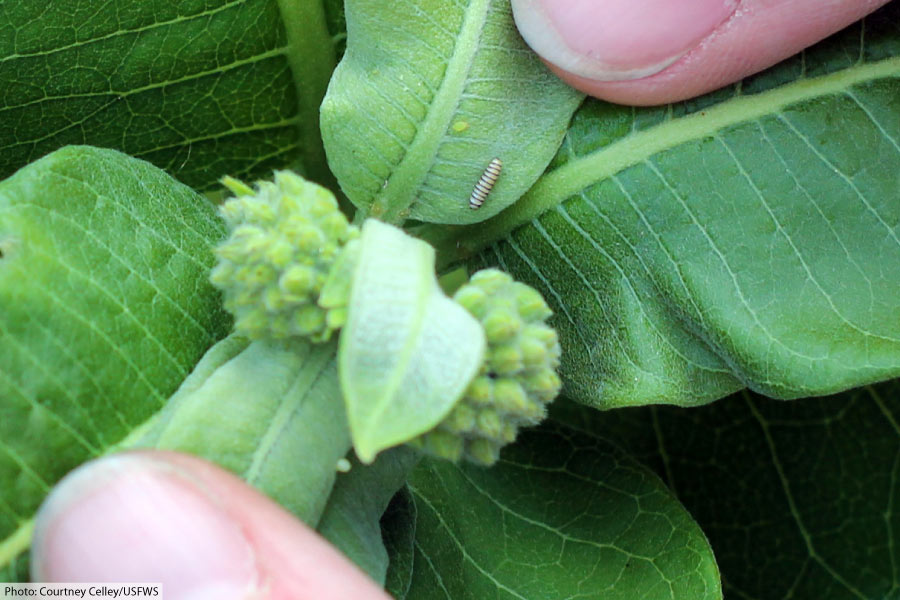
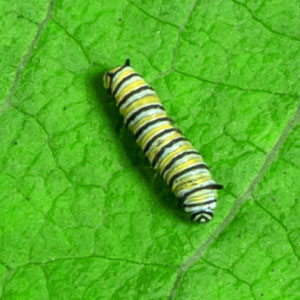
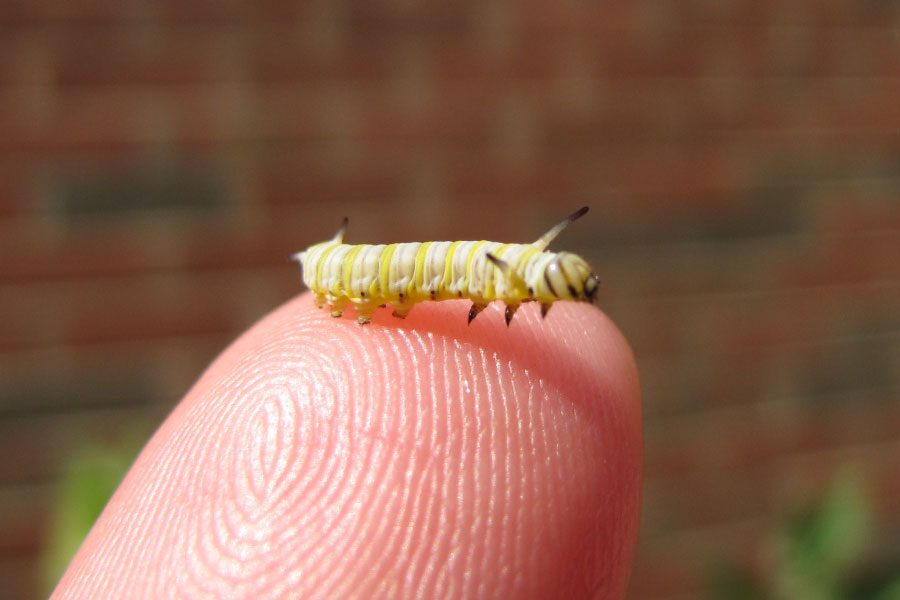
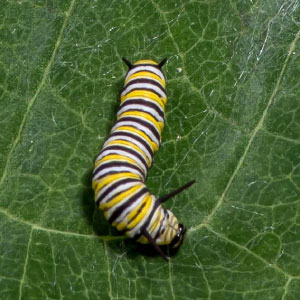
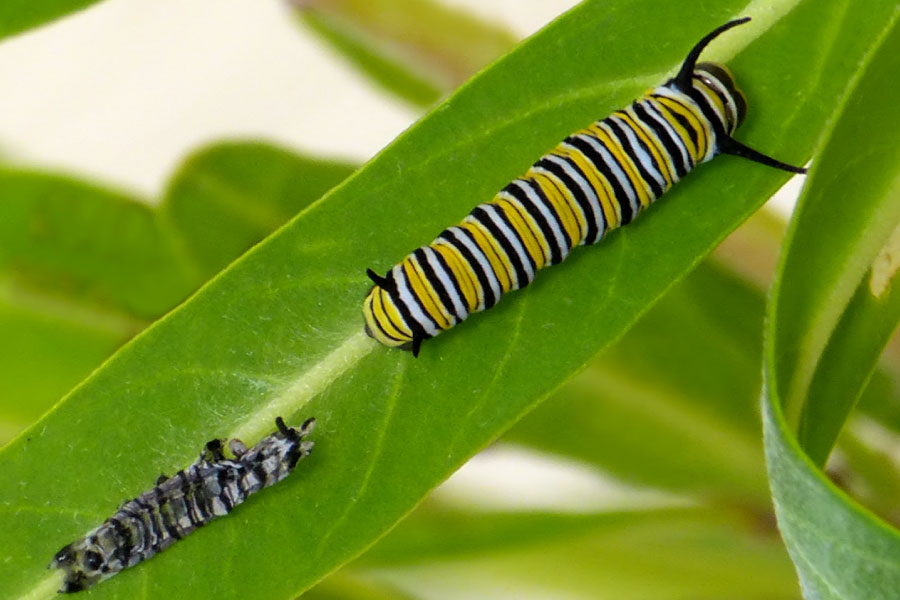
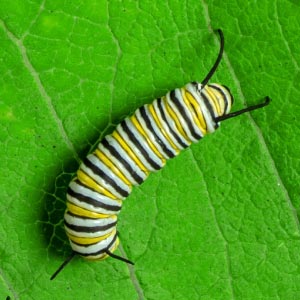
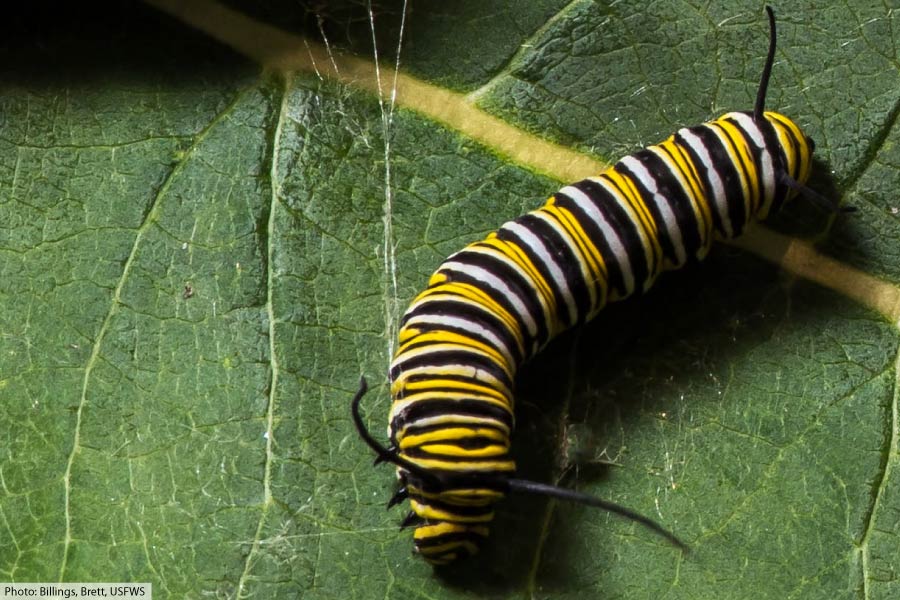
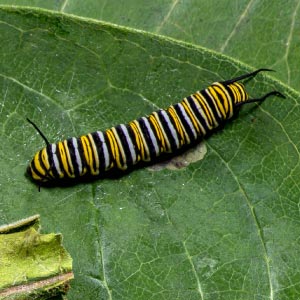
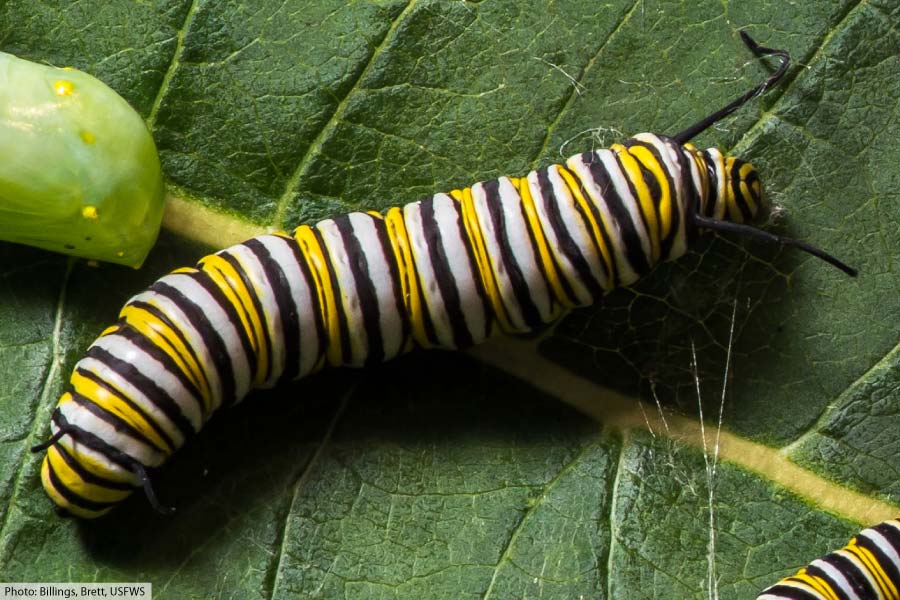
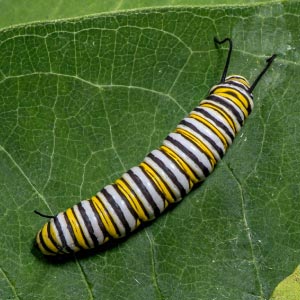

I’d like to introduce some ladybugs to control aphids I’m starting to see on my milkweed. Do ladybugs co-exist with eggs and larva pretty well?
Hello, I live in Northern California and I have approximately 30 to 40 monarch caterpillars on my plant. There is not one leaf left on the plant and wondering what they will do now when they’re ready to go to cocoon. Will they find another spot in the garden, or will they die. There is literally nothing left on the plant for them to hang or attach to but the stocks. This is my first time having them in my yard and I’m super excited but I’m concerned that I’m going to lose them all after all this time. Just looking for info on what might happen next. Thank you for your help and look forward to hearing from you.
Hi,
I ran into that problem last year but with way fewer caterpillars. I posted on next door and asked if anyone was growing milkweed that they could share. I found a neighbor who graciously let me come cut as much as I needed to get them to the butterfly stage.
Hi; I have a milkweed plant that has very small black worms on it. I do not believe they are monarch worms. I removed them. Hope I did it right. They were eating the leaves on the plant. But do not look like Monarch worms. Help!! I am new at this
Ronni
What would happen if you eat a monarch caterpillar?
Monarch caterpillars are poisonous – it’s a survival tactic against predators. We suspect that eating a monarch caterpillar could make you ill (or worse) 🙁
You would probably die or get food poisoning
So this winter in Texas was the warmest on record. I have tons of milkweed in my yard so I have lots of Monarchs. It is December 30th and my back yard is teaming with monarch and other butterflies. Temperatures are supposed to dip to the 20’s this weekend. I read that monarch’s can go into a hibernation? Is this true? And secondly, because they hatched in December prematurely, will that impact their numbers in the spring?
Hi! My daughter has been raising monarch caterpillars we bought online. One chrysalis seems to have fallen off the top of the enclosure and is on the bottom of the enclosure. Should we leave it alone or try to reattach to the roof in some fashion? Thank you!
Hi,
Thank you for your comment.
We haven’t had any experience of this (perhaps another of our readers has and can help?)
Usually, a monarch butterfly emerges from the bottom of the chrysalis, and hangs from what’s left of the chrysalis while its wings expand.
Our feelings are that if the chrysalis is on the floor of the enclosure, then the butterfly may have problems emerging. For this reason it might be a good idea to somehow re-suspend or otherwise position the chrysalis to where emerging may be easier. However, as we say, we don’t have any experience of this and someone else may be able to offer better advice.
Regards,
The Active Wild Team
Our granddaughter pulled a chrysalis off our brick column that had an overhang— not knowing what it was. We put it on top of the overhang. It hatched out!
That’s good to know – many thanks for your comment!
There are many ways to re-attach, look online. However, I have only done that once. In nature, they are knocked down often. I usually take a plastic spoon and carefully scoop it up and place it at a slight angle at the bottom of their habitat. It will emerge and crawl up the side to dry its wings. It takes a little more effort for them this way but all of mine were successful.
I had that happen to me, and I attached the silk thread at the top of the chrysalid road branch using a pin. That seemed to secure it well.
You can take a q tip and rehang it with the cotton. You will also need a pin to pin it back up. You can also leave it on the bottom and make sure it has something to help it crawl up the cage walls if in a cage. All will turn out fine if the monarch is able to crawl to the top of the cage and hang.
Thank you for this advice, it’s much appreciated.
Regards,
The Active Wild Team.
What I’ve done is to superglue the tip of the chrysalis to the underside of a plastic lid…tiny amount of glue ONLY on the web attachment.
Loosely place the lid over a mason jar, or such, and watch closely. When you see it getting dark, and wings showing through, it will hatch in about a day. Butterflies need to hang from something in order to pump the fluid from their body into their wings. If they fall, they won’t make it, unless you can immediately put them where they can cling and straighten their wings.
Also, if one goes into chrysalis on a stem, clip the stem leaving an inch on each side, and tape it to a lid that can be turned over a jar. Be sure the emerging butterfly cannot get its feet caught under or on tape!
Release outdoors near a food source as soon as possible.
Thank you for the tips! 👍😀
Hi there… thanks for all the great info here!
I found 2 caterpillars on my milkweed this week… I live at high elevation and there will be a night a few degrees below freezing in a few days. Are the caterpillars able to withstand that, or should I gently cover the plant with a frost cloth that night? I imagine the chrysalis might be more hardy to such temperatures… is that so? I am so hoping these 2 will be able to complete their metamorphosis!
That’s a great question.
If the temperature falls below freezing then that will make things hard for monarch caterpillars (and pupae) – the species has adapted to migrate rather than “tough it out”, after all.
We can’t say for sure whether or not the caterpillars (or pupae) would survive a light frost, but it obviously would not be the ideal conditions for them. The cold also slows down development, thereby lowering the chances of a successful hatching and subsequent migration.
We imagine frost cloth used at night would help protect your late monarch caterpillars against early frosts, and it may be a good idea to continue on frosty nights when the caterpillars pupate.
(The butterflies won’t fly at temperatures below 55 degrees Fahrenheit, so as long as the frost cloth is removed in the mornings you won’t prevent the butterflies from migrating).
It might give your late monarch caterpillars a fighting chance!
An alternative (if the cold seems to be sticking around) would be to rear the caterpillars indoors / in a garage / outbuilding. It’s not something we always suggest, but it may be enough to speed up their development and get them on their way. (Note that there are rules / regulations against rearing of monarchs / other butterflies in some states / countries.)
There is some good information on rearing monarchs here: https://monarchjointventure.org/images/uploads/documents/MonarchRearingInstructionsUpdated.pdf
We hope this helps, and good luck with your caterpillars!
Regards,
Dan
The Active Wild Team
Weather below 50 isn’t good for a monarch. If you can bring them in where it is warm they will complete their metamorphosis. You will let the wings dry for 24 hours and then release them.
Just noticed what appear to be 2 large Monarch caterpillars on Butterfly Weed in my CT yard; no Milkweed around that I know of. How did they get there??!!
Butterfly weed (orange flowering plant) is also a food source plant of Monarchs. They can survive on it alone.
Butterflyweed is asclepias tuberosa, which is a milkweed.
I always find them on my parsley plants after they have devoured all the leaves. No milkweed near me either.
HI Bill,
I was interested in seeing what kind of response you got because I am having the same problem. I am near Tyler, Tx and I don’t have enough milkweed to support all of my caterpillars. I have as many stage 3 monarchs as you did when asking your question and I’m not sure they will be leaving enough leaves for the ones coming up behind them.
Since I don’t see a response from the active wild team, what did you end up doing? Did you find something else that the younger ones would eat?
Thanks,
Jerri
Hi Bill and Jerri,
Apologies for our belated response.
We’ve researched this quite thoroughly and have come to the conclusion that it’s either milkweed or nothing for monarch caterpillars.
We’d be very grateful if any of our readers could come up with proven milkweed alternatives.
If there really is no greenery left for the caterpillars, then we suggest transporting at least some of them to milkweed plants at a different location, if possible.
It’s a tough call, and we’d usually advise (strongly) against moving / interfering with any wildlife.
Sorry we can’t be more help. We wish you the very best of luck with your caterpillars, and sincerely hope that they make it to pupation (and beyond).
Regards,
The Active Wild Team
Beautiful Blue Tweedia, Oxypetalum coeruleum. This plant is sometimes called “blue milkweed” as it has been known to be a host for the Monarch butterfly (Danaus plexippus). It is related to swan plant and other milkweeds. It is native to South America, from southern Brazil to Uruguay and is loved for its heart-shaped grey-green downy leaves and its clear blue, star-shaped flowers. Tweedia needs full sun in a well-dained, dry soil.
Hi, hope this heps..We’ve had unbelievable luck with Monarch catapillars on our overgrown fennel plant. Quite surprising, as it is right next to a milkweed in our garden that we planted for them but they PREFERRED the fennel instead!! Talk about a happy accident!!
Are you sure these are not black swallowtail cats?
I just found a monarch caterpillar on my butterfly weed plant. Not the traditional milkweed I saw as a kid in Kansas farm fields.
Me too! Wondering where my 2 came from!
Do you mean butterfly bush?
Out of milkweed as a food source for my 13 probably stage 3 monarchs. Please suggest a list of alternative foods I could feed these hungry critters. I have already been successful since 1/1/21 at having 11 new monarchs here in New Orleans. Looking forward to your food suggestion list. Many thanks.
Hi Bill, see our reply to Jerri, above.
The Active Wild Team
Plant a fennel bulb as alternative to milkweed. They love it! We had 13 munching away on it! Parsley too!
Swallowtail caterpillars look very like Monarch caterpillars. Swallowtail caterpillars love parsley and fennel.
Hi. When caterpillars molt, do they lose their head and tentacles? I found them in a cocoon today, and what appears as heads and tentacles on the bottom of the container I had them to protect them from predators.
What you see is the final skin shed. I used to think they lost their heads but it’s just their crumpled up skin. Identical to what they molt and eat at earlier Instars. They aren’t able to eat this one as they are now in cocoon.
The best thing to protect them from predators is bring them inside and individually (1 per jar regardless of how small) raise them in jars.
I recently bought several milkweed plants that already had monarch caterpillars attached! I put the plants in a large open patio that get rather warm, sometimes really hot (100*) during the afternoon hours. Should I find a cooler spot? It’s my first attempt at “raising Monarchs.”
Hi. Thank you for the great information here. It helps me a lot with the 14 caterpillars 🐛 in the habitats on the covered deck, as well as the 6 chrysalides!
I think my fosters are maybe (hopefully) going to molt into 5th instar. Everyone seems very quiet today, almost frozen in place. No munchies right now! They’re all about the same age, within a day or so of hatching. Yesterday, they were very actively munching and all over the place – but today, a cloudy, cool day in Virginia, it’s eerily quiet.
I do have a suggestion. It would be helpful to have a “print” button that puts pages in a nice format without any ads, etc., for printing. I don’t print a lot of pages from the Web but your info with photos is so helpful that I’m printing out your Monarch topics.
Hi Linda,
Thank you for your comment, it certainly sounds as if your caterpillars are preparing to molt! Hopefully you’ll soon have lots of new monarchs to show for your efforts!
Thanks also for your suggestion; we’re always trying to find a balance between providing the information in the best way possible and showing ads (on which we rely to run the site 🙁 ). We may well provide a printable fact sheet at some point in the future.
Enjoy your butterflies!
Regards,
The Active Wild Team
when can I put a caterpillar in a jar and feed it fresh milkweed daily ????????
One of my monarch caterpillars has a black spot on it. I’m worried that it’s a sign of some kind of parasite, but can’t find any information online. Do you know what it could be?
Hi Amy,
We’re sorry to hear that one of your caterpillars appears to be unwell.
Discoloration in monarch caterpillars is most often caused either by Nuclear Polyhedrosis Virus (NPV) or by Pseudomonas bacteria.
Both of these ailments will cause a monarch caterpillar to turn black or brown. Other symptoms include general lethargy, not eating and discharge from either end.
Sadly, the outcome for caterpillars suffering from either of these is not usually good 🙁
Our fingers are crossed that your caterpillars make it through.
Regards,
The Active Wild Team
Good day my friends! I have a problem with my caterpillars chewing on my seed pods. Should I leave the pods on the plant and hope they survive until they open, or are they now not viable?
Hi Catherine,
Difficult to say without seeing the damage, it depends on how developed the seed pods were. We’d be tempted to let nature take its course.
Regards,
The Active Wild Team
Is there a recuperation period after an instar molt? I noticed a caterpillar is not looking too good this morning after molting.
This sounds quite normal, although if it lasts longer than a few hours we might begin to get a little concerned.
Keep an eye on the general condition of the caterpillar’s skin; if its colors start to fade or if black / brown patches begin to appear it may be best to isolate it from other caterpillars, if present.
Regards,
The Active Wild Team
We have several milkweed flowers in our garden and a few in a large pot that we planted to attract the Monarchs. We now have approximately 10 caterpillars of varied sizes on the leaves. We have 5 cats outside that usually want to play with anything that moves or flutters. I have purchased a few butterfly cages as well as watering tubes for the milkweed stems. If I transfer them to the cages would it be best to leave them outdoors under a porch or bring them into the garage? I live in Missouri and the temps have dropped into the low 50’s and into the upper 60’s.
Thanks!
Firstly, congratulations on attracting monarchs to your garden!
It’s very difficult for us to advise fully without knowing the specifics of your space, so please accept the following only as very general advice…
We would keep the plants outside and in the sun for as long as possible, only bringing them into the garage if the temperature was forecast to drop significantly for a few nights. The porch might be a good compromise, as it would likely be (slightly) warmer at night and still get some sun.
As someone who likes to photograph insects, I know that butterflies are surprisingly quick when they have to be! Unless your cats are proven “butterfly hunters”, I personally wouldn’t lose too much sleep over that aspect of the butterflies’ safety.
That said, if you think that the cats could be a threat, then butterfly cages would seem to be a good way of protecting the emerging monarchs.
Thank you for your comment and good luck with your monarchs!
Regards,
The Active Wild Team
Thanks for your advice. Two years ago a few of them unfortunately hatched around our front door facing, within reach of the cats and we found one very injured in the yard, so I’m hoping to avoid that.
Hello! We are so very excited to have three Monarch caterpillars on our milkweed. It took three seasons to finally have milkweed that survived long enough for this beautiful process. The plant is outside in a pot and gets partial sun. At this point I considered buying an enclosure to protect them from predators, but my husband thinks that will deter other Monarchs from continuing to lay eggs and won’t allow the current cats (who are close to pupating) to travel elsewhere to do so. What is your suggestion? Thank you!
Hi Angelique,
Thank you for you comment, and congratulations on your caterpillars!
It’s a tough call! We’d be tempted not to cover the plants; the caterpillars may want to find a suitable pupation site away from the plants, and you never know, another monarch might arrive looking for somewhere to deposit its eggs. There would also be no risk of forgetting to remove the enclosure and trapping the newly-emerged butterflies!
However, the above is without seeing the site and its location. If your instinct is to put up an enclosure then the caterpillars (and pupae) would probably benefit from the additional protection.
Whatever you choose to do we hope that your monarchs successfully pupate and that you have many more caterpillars in the future!
Regards,
The Active Wild Team
I have been raising Monarchs in central Florida for two years and have released over 200. Recently I have several caterpillars raised from eggs that look like monarchs but have a third set of feelers mid body and are slightly darker than the rest. I can send pictures. What is going on?
Hi George,
Thank you for your comment, and for your good work in raising so many monarchs!
We suspect your mystery caterpillars are queen butterfly caterpillars (Danaus gilippus). They’re very similar to monarch caterpillars, but have three, rather than two, pairs of tentacles. Like monarchs, they are found on milkweed. (The chrysalis too is very similar to that of a monarch).
Another similar species is the soldier butterfly (Danaus eresimus), whose caterpillars also have 3 pairs of tentacles.
We hope this helps!
Regards,
The Active Wild Team
I purchased and planted 8 milkweed plants in a group setting. Over the course of a few months, a resident monarch(monarchs) began to deposit eggs. As the caterpillars became evident and reached their final instar, most of the leaves on the milkweed plants were completely eaten.
At this point, I built a screened enclosure which covered the entire area containing the plant’s and caterpillars, just in time as they began to pupate.
As of this morning we counted 51 pupae inside the enclosure…what joy!!!
Dear Dr. Robert,
Thank you for your comment. That’s potentially 51 new monarchs that exist solely thanks to you! We hope you feel suitably proud!
It just goes to show that we can all make a difference.
Enjoy your monarchs!
Regards,
The Active Wild Team
Thanks so much for this valuable information! I have a patio garden and I grow various flowers and vegetables. I also grow milkweed. I had 6 or 7 caterpillars feeding on the milkweed, then soon noticed as they fattened up, they disappeared. I then witnessed one in the process of evolving into the chrysalis stage. I have it on video and took many pictures, It was fascinating! Now, I have no caterpillars and my chrysalis have all emerged, my neighbors and I have enjoyed watching the butterflies flutter around! Will this be a continued process? Will more caterpillars hatch and go through this same process again or is this just a seasonal one time event? My milkweed has revived and ready to be eaten again!! 🙂 Zone 9B
Hi Kelly,
Thank you for your comment; it’s great to hear from people who appreciate their monarchs!
Due to the species’ migratory lifestyle (monarchs are continually on the move) it’s unlikely that you’ll get any more caterpillars this year. However, you may see adult monarchs passing through in the fall as they migrate south for the winter.
Regards,
The Active Wild Team
I just discovered 4 monarch caterpillars on my milkweed. I planted 2 plants a month ago, near to one another. The leaves disappeared from one, then I discovered the caterpillars on the other plant. I’m concerned that they will run out of food as I only have 2 and they are quite small. I put tall webbing around the plant – concerned that the birds may get the caterpillars. My food source is meager I’m afraid.
Hi Terrie,
Thank you for your comment. In most cases it’s best to leave the caterpillars where they are. If the caterpillars are large they may be ready to pupate soon, and hopefully will do so before they run out of food.
Otherwise your options are either trying to get more milkweed plants or transporting the caterpillars (still on the plants) to other milkweeds – perhaps your neighbors or friends / family have some?
It’s a tricky situation and we hope that your monarchs manage to pupate successfully.
Regards,
The Active Wild Team
Please tell me, a couple of my Monarch catapillars go up and down the milkweed stem but every few seconds will raise up the front part of body then continue traveling and raising up. They look very agitated. There are more leaves to be eaten, but they don’t. These are large fat looking about a week old. Anything I can do, ? Are they looking for a place to go into next stage ? I really don’t want to lose them as I love the butterflies.
Hi Sue,
Thank you for your question.
It’s difficult for us to comment on individual cases as we don’t know all of the details (also we’re based in England so unfortunately cannot answer questions from the U.S.A. immediately – sorry).
If your caterpillars have stopped feeding then that’s usually nothing to worry about; they’re probably preparing either to molt or to pupate.
If there’s milkweed and shelter available then it may be best to leave them to their own devices.
Regards,
The Active Wild Team
I have both milkweed and bronze fennel in my pollinator garden. I have Monarchs feeding on the milkweed and I had what I thought were Monarch caterpillars feeding on the fennel . However, although the colors seem similar these have no tentacles. I took a couple of pictures, but have no way to send them. If you know what they may be I would appreciate a headsup.
Dear Herb,
Thank you for your comment. It sounds to us that they could be either black swallowtail or anise swallowtail caterpillars.
Both of these species look similar to monarch caterpillars, but feed on fennel and related plants rather than milkweed.
Unfortunately we (currently) have no way for site visitors to upload photos, but we hope that this has given you something to look into.
Enjoy your butterflies!
Regards,
The Active Wild Team
I have discovered that she is a Painted Lady. I also find I have a Red Admiral. I will have to look closely at the “Monarchs” to see if they are all Monarchs or if I have any Viceroys!!!
We’re glad that you managed to identify your mystery butterfly!
Viceroys are similar to monarchs but are smaller and have an additional black line running from the front to the back of the hindwing. Let us know if you see any!
Regards,
The Active Wild Team
I have a flock of a dozen or so Monarchs this year. They LOVE my purple asters. I noticed a small Monarch looking butterfly, but he has a brownish fuzzy body, not a black spotted one. What is he/she?
I had a pot of parsley and saw what looked like a blue monarch butterfly laying eggs on it. I moved the pot and six weeks or so noticed 6 fat, juicy, orange monarch butterfly caterpillars. I watched for a week and after the week all of the parsley leaves were gone, all that was left were stems but all of the caterpillars were also gone. Did they leave to find more leaves or did they go into their pupa state. Whenever I plant parsley, they feast on it. That’s fine with me.
Hi Janet,
Firstly, are you sure that they were monarchs? (Monarchs have a black & orange coloration). Whatever the species, it’s likely that after having exhausted the food supply, they moved to other plants, either to grow a little more or to pupate.
Thank you for your comment, and enjoy your caterpillars!
Regards,
The Active Wild Team
Janet, it sounds like Eastern Black Swallowtail caterpillars that are eating your parsley. They look a lot like Monarchs but don’t have the front and back “antenna.”
Sounds like you have a black swallowtail here. The caterpillars eat dill, fennel, and parsley!
What is the lifespan of the monarch Butterfly.
Hi Peter,
That’s a good question. It depends on whether an individual is migrating north or south. The lifespan of a northwards migrating monarch is 2 to 5 weeks. That of a south-migrating monarch can be 8 to 9 months. You can find out why there is such a large difference between the lifespans here: Monarch Butterfly Life Cycle.
We hope this helps.
Regards,
The Active Wild Team
I just noticed yesterday a chrysalis on the bottom of my birdbath. I was just checking to see how long it will take for it to become a monarch butterfly. 10 to 14 days. I live in South Florida so I’m already worried about hurricane Dorian….guess if it comes I’ll have to bring it inside. This all started a few years ago when some milkweed came up in my yard. When the caterpillars eat all the leaves I move them to the back where I have a few plants. Does it hurt to move them? Keeps me busy chasing them around. ha, ha. It is such a miracle when I see them emerge & fly away!
Dear Janet,
Thank you for comment. We’re pleased to hear you’re looking out for your monarchs! We don’t think that carefully moving caterpillars to a new source of milkweed is likely to do any harm.
We hope that both you and your chrysalis make it through Hurricane Dorian in one piece! (Our thoughts are with everyone in Florida over the next few days.)
Regards,
The Active Wild Team
When would the monarch emerge from the fifth stage?
Hi Margaret,
After spending around 3 – 5 days in the fifth instar, the monarch caterpillar pupates. It spends around 10 – 14 days in its pupal (chrysallis) stage before emerging as an adult butterfly.
We hope this helps!
Regards,
The Active Wild Team